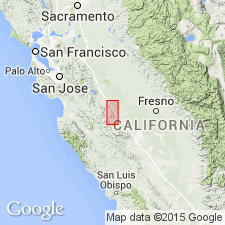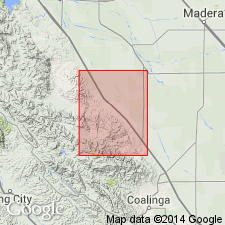
- Usage in publication:
-
- Dosados sand and shale member
- Modifications:
-
- Principal reference
- Dominant lithology:
-
- Sandstone
- Shale
- AAPG geologic province:
-
- San Joaquin basin
Summary:
Pg. 6 (fig. 2), 8 (fig. 4), 9, 22, pls. 2, 3. See also 1941 [abs.], GSA Bull., v. 52, no. 12, pt. 2, p. 1954. Dosados sand and shale member of Moreno formation. Irregularly bedded sands and shales; locally contains dikes. Thickness about 200 feet. Underlies Tierra Loma shale member (new) of Moreno; unconformably overlies Panoche formation. Fossils (vertebrates, foraminifers, invertebrate megafossils). Age is Late Cretaceous. On the basis of this mapping it is concluded that Anderson and Pack (1915) show base of Moreno formation in [Ortegalito] Creek some 1,800 feet stratigraphically lower than their type Moreno in Moreno Gulch.
Type locality: Escarpado Canyon, Panoche Hills, 6 mi south of Moreno Gulch and 2 mi north of Panoche Creek, in secs. 7 and 8, T. 15 S., R. 12 E., [Chounet Ranch 7.5-min quadrangle], Fresno Co., southern CA. Name is contraction of Spanish "dos a dos" [Dosados Canyon is about 0.5 mi north of type locality].
Source: Publication; US geologic names lexicon (USGS Bull. 1200, p. 1143); GNU records (USGS DDS-6; Menlo GNULEX).

- Usage in publication:
-
- Dosados Sandstone and Shale Member*
- Modifications:
-
- Adopted
- Mapped
- Dominant lithology:
-
- Sandstone
- Shale
- AAPG geologic province:
-
- San Joaquin basin
Summary:
Dosados Sandstone and Shale Member of Moreno Formation is adopted by the USGS. (=Dosados Sand and Shale Member of Payne, 1951.) Consists of dark-brown silty shale and interbedded thin, fine-grained, turbidite sandstone beds; also contains generally thick channelized bodies of poorly bedded sandstone. Thickness up to about 60 m [about 197 feet]. In places mapped [undifferentiated] with Tierra Loma Shale Member. Age is Late Cretaceous (Maestrichtian).
Type section: Escarpado Canyon, [6 mi south of Moreno Gulch and 2 mi north of Panoche Creek, Panoche Hills], in sec. 7, T. 15 S., R. 12 E. and in sec. 12, T. 15 S., R. 11 E., Chounet Ranch 7.5-min quadrangle, Fresno Co., southern CA (see Payne, 1951).
Source: Publication; GNU records (USGS DDS-6; Menlo GNULEX).
For more information, please contact Nancy Stamm, Geologic Names Committee Secretary.
Asterisk (*) indicates published by U.S. Geological Survey authors.
"No current usage" (†) implies that a name has been abandoned or has fallen into disuse. Former usage and, if known, replacement name given in parentheses ( ).
Slash (/) indicates name conflicts with nomenclatural guidelines (CSN, 1933; ACSN, 1961, 1970; NACSN, 1983, 2005, 2021). May be explained within brackets ([ ]).

